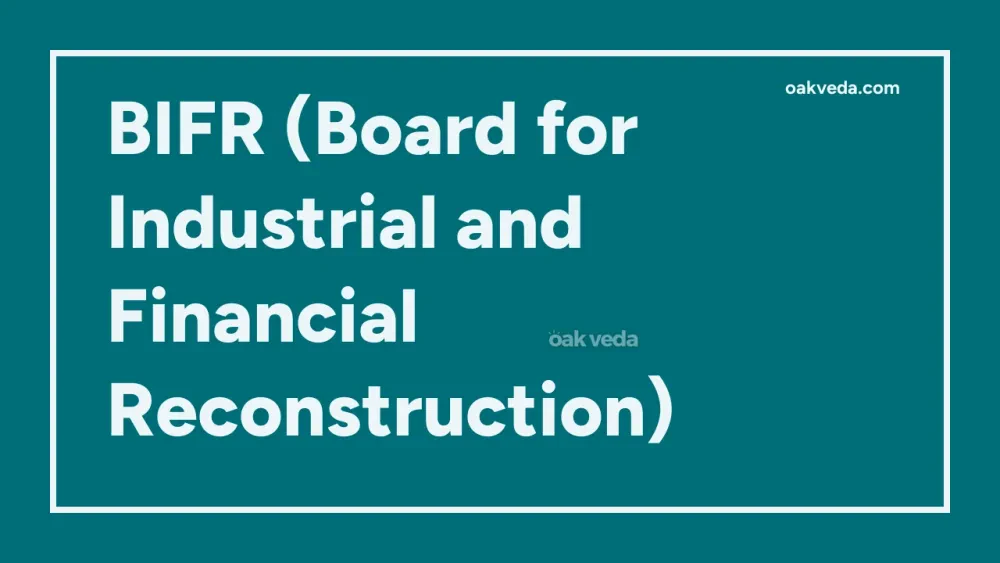
What is the Full Form of BIFR?
BIFR is the abbreviation for the Board for Industrial and Financial Reconstruction. This government agency played a crucial role in India's industrial and financial landscape for nearly three decades.
What is Board for Industrial and Financial Reconstruction?
The Board for Industrial and Financial Reconstruction (BIFR) was a specialized agency established by the Government of India under the Ministry of Finance. Its primary purpose was to address the issue of industrial sickness in the country by restructuring and reviving ailing companies or recommending their closure when necessary.
Origin and Development of Board for Industrial and Financial Reconstruction
The concept of BIFR emerged from India's struggle with industrial sickness, which began even before the country gained independence. Here's a brief timeline of its development:
- 1981: The Tiwari Committee was formed to address industrial sickness.
- 1985: The Sick Industrial Companies Act (SICA) was enacted based on the committee's recommendations.
- January 1987: BIFR was officially established under SICA.
- April 1987: The Appellate Authority for Industrial & Financial Reconstruction (AAIFR) was created to hear appeals against BIFR decisions.
- 1991: SICA's jurisdiction was extended to include government companies.
- 2003: The Sick Industrial Companies (Special Provisions) Repeal Act was passed, paving the way for BIFR's eventual dissolution.
How did the Board for Industrial and Financial Reconstruction work?
BIFR operated as a quasi-judicial body, focusing on large and medium-sized sick industrial enterprises. Its primary functions included:
- Identifying sick industrial companies
- Investigating the reasons for their sickness
- Formulating rehabilitation schemes for viable companies
- Recommending the closure of non-viable units
The board consisted of a chairperson and between two to fourteen other members. These members were typically retired High Court judges or professionals with at least 15 years of relevant experience.
Functions of Board for Industrial and Financial Reconstruction
The key functions of BIFR included:
- Assessment: Evaluating the financial health of industrial companies
- Revival Planning: Developing and implementing rehabilitation schemes for sick units
- Monitoring: Overseeing the progress of revival plans
- Liquidation Recommendations: Suggesting the winding up of non-viable companies
- Coordination: Liaising with banks, financial institutions, and other stakeholders
- Policy Advice: Providing recommendations to the government on industrial sickness prevention
Applications of Board for Industrial and Financial Reconstruction
BIFR's applications extended to various sectors of the Indian economy:
- Manufacturing: Assisting sick units in traditional and modern manufacturing sectors
- Textiles: Addressing issues in one of India's oldest and largest industries
- Steel: Helping revive struggling steel plants
- Pharmaceuticals: Supporting ailing pharmaceutical companies
- Automotive: Assisting car and auto parts manufacturers facing financial distress
Features of Board for Industrial and Financial Reconstruction
Some notable features of BIFR included:
- Quasi-judicial Authority: Empowered to make binding decisions on stakeholders
- Expertise: Comprised of experienced professionals from various fields
- Holistic Approach: Considered financial, operational, and market factors in its assessments
- Time-bound Processes: Aimed to expedite the revival or closure of sick units
- Appellate Mechanism: Decisions could be appealed to AAIFR
Benefits of Board for Industrial and Financial Reconstruction
BIFR offered several benefits to the Indian industrial sector:
- Industrial Revival: Helped in the turnaround of many sick companies
- Job Preservation: Saved employment in revived industries
- Asset Utilization: Prevented the wastage of industrial assets
- Creditor Protection: Assisted in the recovery of dues for banks and financial institutions
- Economic Stability: Contributed to the overall health of the industrial sector
Limitations or Challenges of Board for Industrial and Financial Reconstruction
Despite its intentions, BIFR faced several challenges:
- Delayed Processes: Cases often took years to resolve
- Limited Success Rate: Many companies couldn't be revived despite interventions
- Resistance from Stakeholders: Sometimes faced opposition from management or labor unions
- Changing Economic Landscape: Struggled to adapt to the liberalized economy post-1991
- Resource Constraints: Often lacked adequate resources to handle the volume of cases
Future Developments in Industrial Reconstruction
While BIFR has been dissolved, its objectives continue to be relevant. The government has introduced new mechanisms to address industrial sickness:
- Insolvency and Bankruptcy Code (IBC): Introduced in 2016 to streamline and expedite the resolution of insolvency cases
- National Company Law Tribunal (NCLT): Replaced BIFR as the adjudicating authority for corporate insolvency
- National Company Law Appellate Tribunal (NCLAT): Serves as the appellate authority, replacing AAIFR
These new institutions aim to address the limitations of BIFR while continuing its mission of industrial revival and reconstruction.
FAQs on BIFR Full Form
-
When was BIFR established? BIFR was established in January 1987 under the Sick Industrial Companies Act (SICA) of 1985.
-
What was the main purpose of BIFR? The main purpose of BIFR was to detect industrial sickness and assist in reviving viable sick industrial companies or recommending the closure of non-viable ones.
-
Who could approach BIFR? Large and medium-sized industrial companies facing financial difficulties could approach BIFR for assistance.
-
When was BIFR dissolved? BIFR was dissolved in 2016 following the enactment of the Insolvency and Bankruptcy Code.
-
What has replaced BIFR? The National Company Law Tribunal (NCLT) has taken over the functions of BIFR under the new insolvency resolution framework.
In conclusion, while the Board for Industrial and Financial Reconstruction is no longer operational, its legacy in addressing industrial sickness and its impact on India's economic landscape remains significant. The lessons learned from BIFR's experiences continue to shape the country's approach to corporate insolvency and revival.
You may be interested in:

